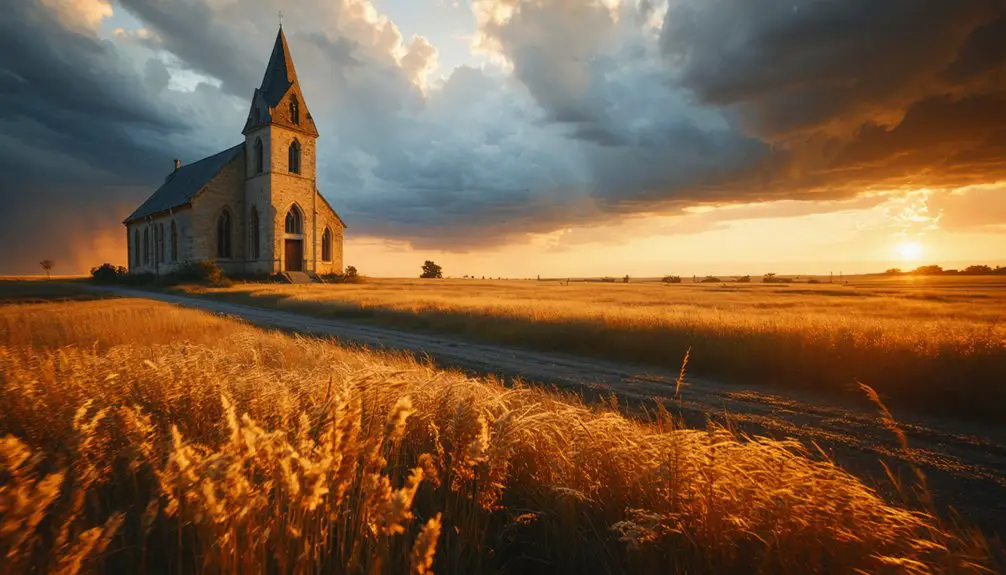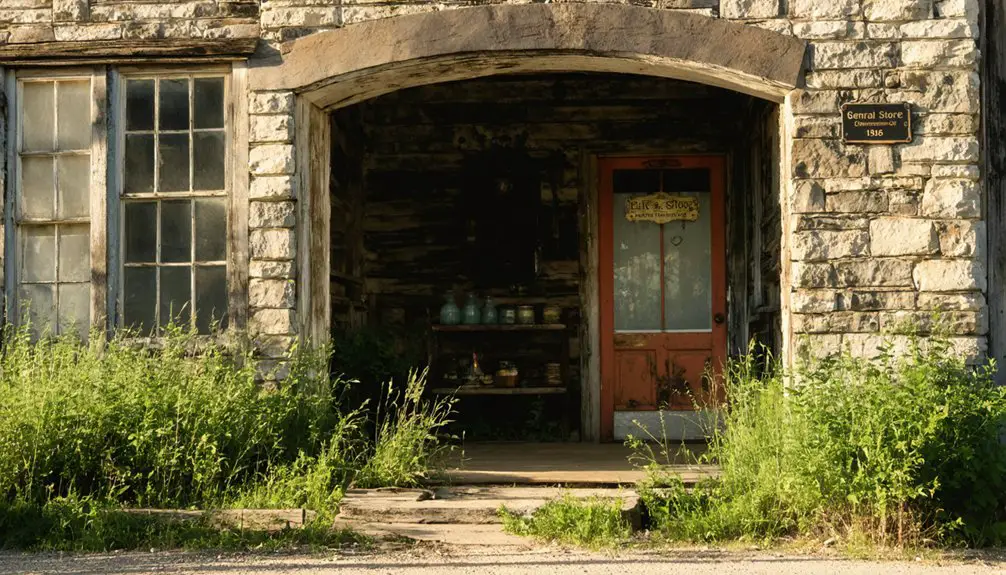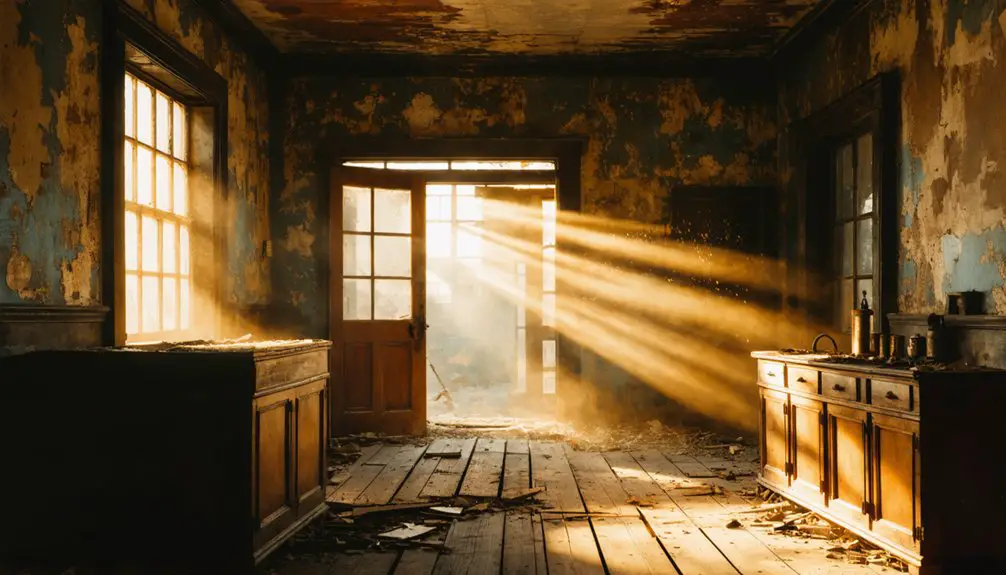You’ll find Elk Falls, Kansas – established in 1870 – proudly wearing its title as the “World’s Largest Living Ghost Town.” While its population has dwindled from over 600 residents to just a handful today, the town’s historic structures, natural waterfall, and famous annual Outhouse Tour keep it far from forgotten. From its railroad boom days to its current status as a preserved piece of frontier history, this unique community’s story spans over 150 years of American transformation.
Key Takeaways
- Elk Falls, Kansas is known as the “World’s Largest Living Ghost Town” despite maintaining a small active population.
- Founded in 1870, the town peaked at around 800 residents in the 1890s but has since declined to about 20% of that population.
- The historic town features preserved structures, including a Pratt Truss Bridge and various abandoned buildings from its heyday.
- Now famous for its annual Outhouse Tour, Elk Falls attracts tourists with its blend of historic sites and quirky attractions.
- The town gained official recognition when listed on the National Register of Historic Places in 1994 for its historical significance.
The Birth of a Frontier Settlement
As frontier settlements spread across Kansas in the early 1870s, Elk Falls emerged as a promising new community in the state’s Ozark region near the Oklahoma border. R.H. Nichols, along with six other businessmen, faced frontier challenges head-on as they established the townsite in February 1870.
You’ll find the settlement dynamics were swift and purposeful. Nichols built the first house, which served as both home and business office, while the town company laid out lots for future growth. Similar to other Kansas towns like Cave Springs, settlers could purchase 64 blocks for development.
Essential services quickly followed – a general store, drug store, and blacksmith shop sprung up to serve the growing population. The community’s spiritual and educational needs weren’t forgotten either, with a Methodist Episcopal Church congregation forming and Miss Dora Simmons teaching 25 pupils in a private home. The town’s rapid growth was evident as the population reached 513 residents by 1880.
Early Town Life and Development
You’d find a bustling frontier economy in early Elk City, where John Kappell’s 1868 trading post paved the way for essential businesses like general stores, drug stores, and blacksmith shops.
The town’s educational foundation began with Miss Dora Simmons teaching 25 students in her father’s home around 1870, shortly before a dedicated schoolhouse was built that doubled as the Methodist Episcopal Church.
The community’s growth included multiple postmasters operating from general stores, creating a crucial communication hub for the expanding settlement. Similar to the Wayside Post Office, these mail services continued until postal consolidation restructured rural delivery. Following a pattern seen in many Kansas settlements, the town experienced a sharp decline when bad weather conditions devastated local farming operations.
Pioneer Business Development
During the early development of Elk City and Elk Falls, pioneer businesses emerged to meet settlers’ essential needs. You’d find A.E. Baird’s general merchandise store operating from a log building, while pioneer innovation drove the establishment of essential sawmills by S.B. Davis and T.J. Brown to process local timber. As Civil War veterans increasingly settled in the area, they contributed significantly to business growth.
Business resilience was evident in the diverse enterprises that took root. Wright and Kirby’s steam sawmill supplied lumber for the growing town’s construction needs, while M.D. Wright’s stationery and notion store doubled as the post office. The town’s economic growth accelerated when the Kansas City Railway arrived in 1879.
Drug stores and blacksmith shops rounded out the commercial landscape, providing critical services to the developing community. These early entrepreneurs didn’t just run businesses – they built the foundation for a thriving frontier economy through their determination and adaptability.
School and Church Growth
The pioneers of Elk Falls recognized that a thriving town needed more than just commerce – it needed places of learning and worship. The school community started in 1870 when Miss Dora Simmons taught 25 pupils in her father’s home, while William Osborne held classes in a log house in nearby Elk City.
As the town grew, you’d find these essential developments:
- A dedicated frame schoolhouse was built in 1871, serving double-duty as the Methodist Episcopal Church.
- The school community flourished for nearly a century until 1964.
- Church activities expanded to four congregations during the town’s peak, providing social stability and moral guidance.
These institutions fostered community bonds and resilience through floods, economic shifts, and the challenges of frontier life.
Post Office Establishment
Shortly after pioneers laid out the townsite in 1870-1871, Elk Falls established its first post office, marking a crucial milestone in the community’s development.
The post office significance extended beyond mail delivery – it helped establish Elk Falls as a regional hub in the Kansas Ozarks. You’ll find it was strategically planned by R.H. Nichols and six businessmen who recognized its importance for growth and commerce. Similar to nearby Grenola, where the post office initially operated from a covered wagon, mail services were vital to early settlement.
This crucial community connection point supported the town’s expanding population, which reached over 500 residents by the 1880s.
The post office strengthened Elk Falls’ bid for county seat status and facilitated the emergence of other essential businesses, including a general store, drug store, and blacksmith shop. The spectacular truss bridge, built in 1893, further enhanced the town’s infrastructure and connectivity.
It served as a lifeline for residents before modern communication methods emerged.
Rise to Regional Prominence
You’ll find that Elk Falls quickly established itself as a regional hub after its 1870 founding, growing to support four churches, multiple hotels, and various businesses that served over 600 residents at its peak.
The town’s economic foundation rested on nearby strip coal mines, which provided vital employment and commerce opportunities for the community. Today, Elk Falls embraces its legacy as the World’s Largest Living ghost town, drawing visitors to explore its historical remains.
While lacking formal law enforcement, the bustling settlement attracted various professionals, including a doctor and judge, along with essential services like trading posts and sawmills that cemented its importance in Howard County.
Early Commercial Growth
Following its establishment as a trading post in 1868, Elk City rapidly developed into a bustling commercial center, drawing entrepreneurs and settlers to its strategic location at the confluence of Duck Creek and the Elk River.
Similar to neighboring town of Moline, which experienced rapid growth through railroad development and business establishment, Elk City’s commercial expansion flourished as business diversity took root, transforming the settlement into a crucial regional hub.
Early commercial development included:
- General stores by A.E. Baird and the Hart brothers, providing essential goods
- Industrial operations including S.B. Davis’s sawmill and T.J. Brown’s blacksmith shop
- Financial and communication services through two banks, express offices, and a post office established in 1869
Railroad Era Influence
The arrival of multiple railroad lines in the late 19th century transformed Elk City into an essential regional transportation hub. You’d find the Elk & Chautauqua Railroad connecting with the Atchison, Topeka & Santa Fe line, creating crucial links to markets from Chicago to the Gulf Coast.
This railroad connectivity sparked remarkable economic transformation throughout the region. You could see it in the rising freight tonnage, improved earnings per mile, and the emergence of flour mills taking advantage of new distribution routes.
The rail network’s presence drew settlers, pushing Elk City’s population to nearly 800 residents by the 1890s. Supporting infrastructure sprouted up, including telegraph offices, express services, and banks. These developments helped establish Elk City as a significant player in Kansas’s commercial landscape during the railroad era.
Natural Wonders and Scenic Beauty

Nestled within the Kansas Ozarks, Elk Falls showcases its crown jewel – a scenic waterfall visible from Montgomery Street’s eastern end, just beyond the historic 1893 Iron Truss Bridge.
The area’s natural beauty and ecological diversity shine through its rolling hills and dense woodlands.
You’ll discover pristine environments perfect for outdoor exploration, including:
- The Rock Garden, a 1930s artistic interpretation of local geology, now home to Elk Falls Pottery
- Rugged hiking trails winding through undisturbed Elk River Valley forests
- Prime bird-watching spots amid native flora and preserved habitats
The waterfall’s dynamic flow changes with the seasons, while surrounding landscapes remain largely undeveloped, offering you peaceful solitude among Kansas Ozark terrain.
The minimal industrial activity and low population density help preserve these natural wonders for future generations.
Cultural Legacy and Unique Attractions
Beyond its natural splendor, Elk Falls proudly embraces its identity as the “World’s Largest Living Ghost Town” and “Outhouse Capital of the World.”
A whimsical Kansas town where ghostly charm meets outhouse fame, proving even small places can create big identities.
These distinctive titles reflect a community that’s turned its small-town status into a cultural advantage, drawing visitors to its blend of historic charm and quirky attractions.
You’ll discover the town’s cultural identity through its annual Outhouse Tour, held before Thanksgiving, where creatively decorated outhouses showcase local humor and artistry.
The historic Rock Garden, home to Elk Falls Pottery for over 30 years, represents the town’s artistic heritage.
Despite having only 100 residents, the community actively maintains its unique character through festivals, craft shows, and preservation efforts.
The Friends of Elk Falls Association helps coordinate these activities, ensuring this quirky tourism destination maintains its authentic small-town spirit.
Preservation Efforts Through Time

Since its early days as a thriving settlement, Elk Falls has maintained its historic character through dedicated preservation efforts spanning decades.
The town’s historic significance received official recognition when the Kansas State Historical Society designated it as a historic site in 1992, followed by its listing on the National Register of Historic Places in 1994.
Through strong community involvement, you’ll discover how residents have protected their heritage:
- Saved the Pratt Truss Bridge from demolition in 1983, converting it to a footbridge
- Promoted the town as the “World’s Largest Living Ghost Town,” attracting artists and tourists
- Preserved historic structures through adaptive reuse, including the schoolmaster’s home and local cemeteries
These grassroots efforts have successfully balanced preservation with economic sustainability, ensuring Elk Falls’ story endures for future generations.
Modern Day Ghost Town Experience
Today in Elk Falls, you’ll discover a rare blend of historic preservation and small-town energy that exemplifies its status as the “World’s Largest Living Ghost Town.”
With a population hovering at just 20% of its peak, the town maintains essential services like a post office while embracing its unique identity through attractions such as the historic Pratt Truss Bridge and the quirky annual Outhouse Tours.
While exploring this rural heritage site, you’ll find abandoned structures alongside active businesses, creating an authentic ghost town tourism experience.
You can visit the remaining original buildings, including churches and historic residences, or participate in walking tours and seasonal craft fairs.
Though the local school closed in 1964, the community’s spirit lives on through small businesses, bed & breakfasts, and regular events that celebrate Elk Falls’ distinctive character.
Frequently Asked Questions
What Happened to the Original County Seat Status of Elk Falls?
Your original county seat lost its status through fierce battles with rival towns, legal challenges, and armed conflicts, ultimately ending when Howard County split into Elk and Chautauqua counties in 1875.
Are There Any Paranormal or Haunted Locations Within Elk Falls?
Despite its “ghost town” status drawing 1,000+ annual visitors, you won’t find documented haunted history or verified ghost sightings in Elk Falls. The nickname reflects population decline rather than paranormal activity.
How Many Permanent Residents Currently Live in Elk Falls?
You’ll find Elk Falls’ current population hovers around 106-113 permanent residents, with a steady decline rate. The town’s historically significant community now consists primarily of older adults, with a median age of 61.5.
What Businesses Still Operate in Elk Falls Today?
Presently, you’ll find precious few businesses: a small local eatery near the historic swinging bridge, a pottery shop, and basic municipal services supporting the town’s remaining handful of residents.
When Did the Annual Outhouse Tours Tradition First Begin?
You’ll find the outhouse history of this annual tradition dates back to 1996, when locals first established the quirky festival to draw visitors and celebrate their community’s unique spirit.
References
- https://www.legendsofamerica.com/ks-elkfalls/
- https://legendsofkansas.com/cave-springs-kansas/
- https://en.wikipedia.org/wiki/Le_Hunt
- https://www.onlyinyourstate.com/state-pride/kansas/ks-largest-living-ghost-town
- https://www.youtube.com/watch?v=TkpFQ-8uEgQ
- https://www.hhhistory.com/2019/05/ghost-towns-of-kansas.html
- https://en.wikipedia.org/wiki/Cave_Springs
- https://photos.legendsofamerica.com/blog/2015/10/kansas-rail-towns-and-little-house-on-the-prairie
- https://legendsofkansas.com/elk-city-kansas/
- https://genealogytrails.com/kan/elk/PioneerDays.html



